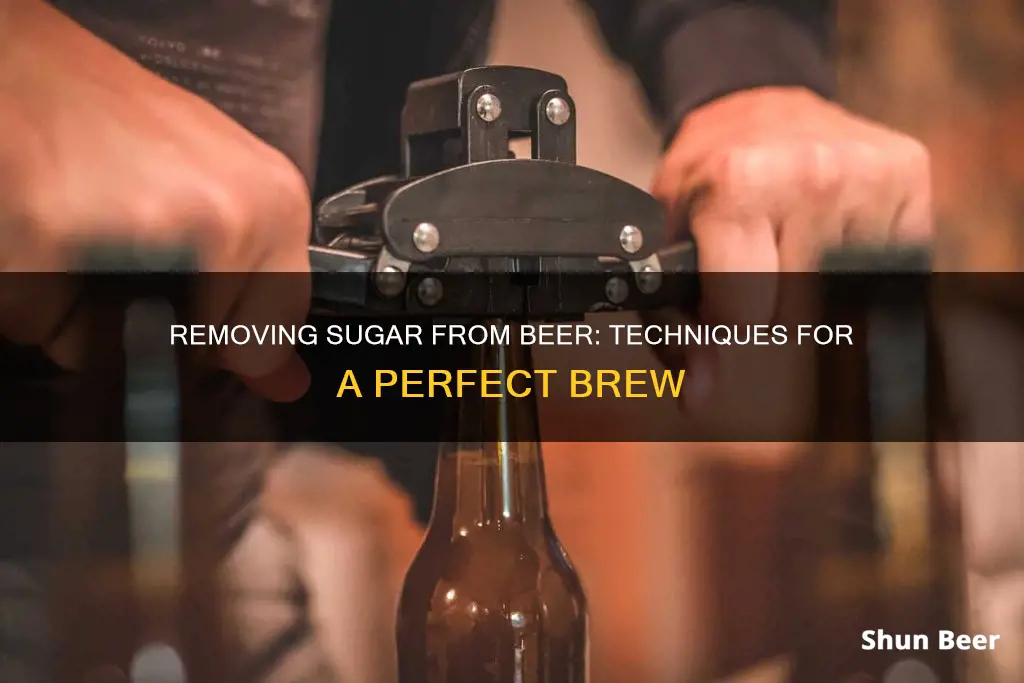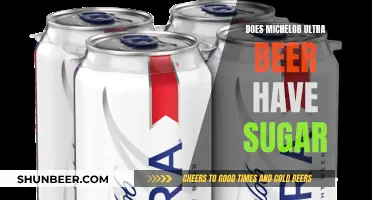
Beer is made from water, grain, hops, and yeast. The grain is usually malted barley, which is the source of the sugar in beer. The yeast enables the fermentation of the sugars in the malted barley to form alcohol. The process turns sugar into alcohol. While sugar is not added as an ingredient, it is necessary for the production of alcohol.
There are ways to reduce the sugar content in beer, such as adding a more attenuative yeast or using other microorganisms to consume non-fermentable sugars. However, these methods can also affect the flavour and mouthfeel of the beer.
What You'll Learn

The role of yeast in the fermentation process
Yeast plays a crucial role in the fermentation process, which is used to make alcoholic and non-alcoholic beverages, as well as bread and other by-products. Yeast is a eukaryotic microorganism that can be found in a variety of ecological niches, including water, soil, air, and the surfaces of plants and fruits.
During fermentation, yeast converts carbohydrates, such as starch or sugar, into alcohol or acid. In the context of beer production, yeast is added to the wort (a sugar-containing liquid derived from germinated grains) and it ferments the sugars present, converting them into alcohol (ethanol) and carbon dioxide. This process is described by the following chemical equation:
> C6H12O6 → 2C2H5OH + 2CO2
Yeast is also responsible for producing hundreds of secondary metabolites that influence the aroma and taste of beer. The variation in these metabolites across different yeast strains gives yeast a unique influence on beer flavour.
The most commonly used yeast in beer fermentation is Saccharomyces cerevisiae, which is known for its satisfactory fermentative capacity, rapid growth, and easy adaptation. It is also highly efficient at converting sugar into alcohol. However, other non-Saccharomyces yeasts are sometimes used to modify the sensory quality of the beer.
In addition to its role in beer fermentation, yeast is also used in the production of other alcoholic beverages such as wine, cider, and various fruit-based drinks, as well as non-alcoholic products like bread, chocolate, coffee, and even biofuels.
Sugar in Beer: How Much is Too Much?
You may want to see also

The impact of sugar on the alcohol content of beer
Sugar plays a crucial role in determining the alcohol content of beer. While sugar is not directly added to the beer, it is produced during the germination of grains, such as barley and wheat, which are the most commonly used grains in the brewing process. This sugar, mainly in the form of maltose, is then fermented by yeast to produce alcohol.
The density of the wort, or the sugar-containing liquid extracted from the grains, is known as beer gravity. A high gravity wort has a high sugar concentration, which, when fermented, results in a beer with a high alcohol content. As the yeast ferments the wort, the sugar content decreases while the alcohol content increases, leading to a decrease in the beer's gravity. Therefore, the difference between the initial and final gravity of the beer indicates the amount of sugar converted into alcohol.
The type of yeast used in brewing also impacts the alcohol content. Ale yeasts, or Saccharomyces cerevisiae strains, have a higher alcohol tolerance than lager yeasts, allowing them to survive in higher alcohol environments. As a result, ales tend to have a higher alcohol content and lower sugar content compared to lagers.
Additionally, the addition of extra sugar or honey to certain beers, such as real ales, can further increase the alcohol content. However, it is important to note that the presence of sugar in beer does not necessarily mean a high alcohol content, as the sugar may be in the form of non-fermentable oligosaccharides, which the yeast cannot convert into alcohol.
Removing sugar from beer is a complex process and can be challenging without negatively affecting the flavor or mouthfeel. While it is possible to add more attenuative yeast to reduce residual sugar, it may still impact the flavor. Overall, the impact of sugar on the alcohol content of beer is significant, and brewers can manipulate the sugar content to influence the final alcohol concentration in the beer.
Priming Sugar for Beer: 5-Gallon Secrets
You may want to see also

How to remove sugar without affecting flavour or mouthfeel
Removing sugar from beer without affecting flavour or mouthfeel is a challenging task, and it is not possible to do so cheaply. Here are some methods that can help reduce sugar content:
Fermentation:
By adding yeast and allowing the beer to ferment, the sugar can be converted into alcohol. This method depends on the sugar and pH levels of the beer and must be conducted properly to avoid the formation of acetic acid, which can give the beer a vinegary taste.
Amylase Enzyme:
Adding an amylase enzyme during fermentation can help create a highly fermentable wort, converting sugars into alcohol. However, this method may not be effective for removing all sugars and can impact the final product's alcohol content and style.
Attenuative Yeast:
Using a more attenuative yeast can help reduce residual sugar content. However, this method may affect the flavour and is not suitable for all beers.
Microorganisms:
Introducing other microorganisms that consume non-fermentable sugars can significantly reduce sugar content. However, this method will result in noticeable flavour changes.
Temperature Control:
Maintaining strict temperature control during fermentation is crucial to preventing hot alcohol flavours from dominating the beer. This can help balance the beer's flavour and mouthfeel, making any remaining sugars less noticeable.
It is important to note that attempting to filter or selectively remove sugars from finished beer is unlikely to be successful without impacting flavour or mouthfeel. The methods mentioned above focus on reducing sugar content during the brewing process without negatively affecting the final product.
Best Sugar-Free Beers: Enjoy Guilt-Free Sipping
You may want to see also

The difference between maltose and fructose
Removing sugar from beer is a complex process that can affect the flavour and mouthfeel of the final product. While it is possible to use enzymes like amylase to create a highly fermentable wort, thereby converting more sugars into alcohol, it is challenging to remove sugars without impacting the beer's overall character.
Now, when it comes to the difference between maltose and fructose, there are several key distinctions to be made.
Maltose, also known as malt sugar, is a disaccharide, which means it is composed of two glucose molecules. It is formed during the malting process, which involves the controlled germination of grains such as barley or wheat. This step is crucial in beer-making as it helps break down the stored starch in the grains into fermentable sugars, primarily maltose. During the mashing process, the germinated grains are roasted, milled, and soaked in hot water, resulting in a sugar-containing liquid called wort. The wort is then boiled, cooled, and filtered before yeast is added to initiate fermentation, converting the sugars into alcohol.
On the other hand, fructose, also known as fruit sugar, is a monosaccharide or "simple sugar." It is found naturally in fruits, vegetables, honey, sugar beets, and sugar cane. Fructose is one of the three main monosaccharides that our bodies consume, along with glucose and galactose. In the body, fructose is metabolised in the liver through a process that does not require insulin, which is why it does not raise blood glucose levels like other sugars.
In terms of their chemical structure, maltose is a disaccharide composed of two glucose molecules, while fructose is a monosaccharide. This difference in structure also leads to variations in how they are metabolised by the body. While maltose is broken down into glucose during digestion, fructose does not require this conversion and can be metabolised directly.
Additionally, maltose is a significant component of the beer-making process, contributing to the fermentation process and the production of alcohol. Fructose, on the other hand, is not as prominent in beer-making, although it may be present in small amounts depending on the ingredients used.
In summary, the key differences between maltose and fructose lie in their chemical structure, metabolic pathways, and their respective roles in beer-making. While maltose is a disaccharide composed of two glucose molecules and plays a central role in fermentation during beer production, fructose is a monosaccharide found in fruits and other natural sources, and it follows a different metabolic pathway in the body.
Sam Adams Beer: Sugar Content and Health
You may want to see also

How to reduce sugar content by limiting hops
It is not possible to completely remove sugar from beer, as it is an essential element in the beer-making process. Sugar is required for the yeast to produce alcohol. However, there are ways to limit the sugar content by reducing the amount of hops used and making adjustments to the brewing process. Here are some tips on how to reduce the sugar content in beer by limiting hops:
Limit the Hop Load:
Hops contribute a small amount of sugar to the beer, and a higher hop load will add more sugars. By reducing the amount of hops used, you can lower the sugar content. Keep in mind that hops also contribute to the bitterness and aroma of the beer, so adjusting the hop load may require some experimentation to find the right balance.
Keep the Grain Bill Simple:
Use a simple grain bill with a lower amount of unfermentable sugars. This will limit the amount of sugar available for the hops to work on, resulting in a lower overall sugar content in the beer.
Mash at a Lower Temperature:
By mashing at a lower temperature, you can limit the amount of unfermentable sugars that are produced. This will result in less sugar for the yeast to ferment, leading to a lower sugar content in the final product.
Use a Combination of Pellets and Cryo Hops:
Consider using a combination of T-90 pellets during active fermentation and Cryo hops toward the end of the process. Cryo hops reduce the enzymatic potential of the hops while brightening the aroma. Replacing some of the pellets with Cryo hops can help to lower the overall sugar content in the beer.
Avoid Over-Dry Hopping:
While dry hopping is a common technique to enhance the aroma of hops, excessive dry hopping can liberate more fermentable sugars in the beer. Limit the amount of dry hopping or consider alternative methods to achieve the desired aroma without increasing the sugar content.
Monitor Fermentation and Yeast Health:
Keep a close eye on the fermentation process and check the yeast health regularly. A stuck fermentation or stressed yeast can lead to off-flavors and other undesirable characteristics in the beer. Maintaining a healthy fermentation process will help ensure that the yeast efficiently ferments the available sugars.
It's important to note that reducing the sugar content in beer can be a delicate process and may require some trial and error. Each brewery may need to develop its own strategy based on their specific recipes and processes. Additionally, keep in mind that limiting hops may also affect other characteristics of the beer, such as bitterness and aroma.
Sour Beers: More Sugar, More Problems?
You may want to see also
Frequently asked questions
It is not possible to remove sugar from beer without affecting its flavour or mouthfeel. However, you can reduce the residual sugar content by adding a more attenuative yeast, but this may also affect the flavour.
Sugar is an essential element in the beer-making process, as it is fermented by yeast to produce alcohol.
Beer's sugar content varies depending on its initial gravity and the type of yeast strain used to ferment it. However, beer manufacturers may include sugar-containing ingredients like honey and corn syrup to create a distinctive flavour.
If you are looking for a sugarless drink, your best options are alcoholic beverages that are naturally low in sugar, such as hard liquor, vodka, gin, tequila, rum, and whisky.







